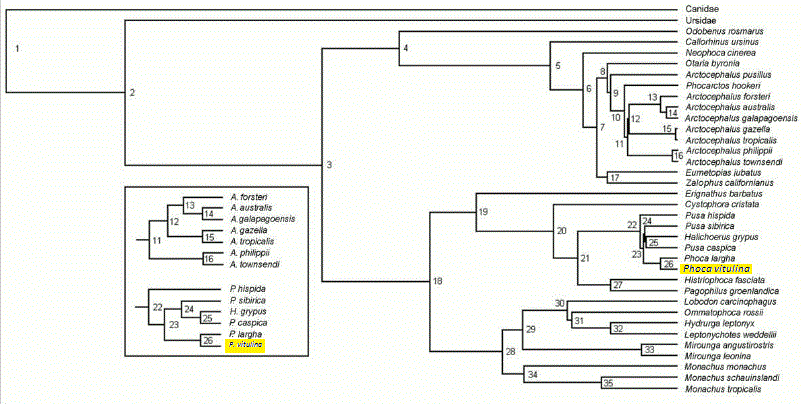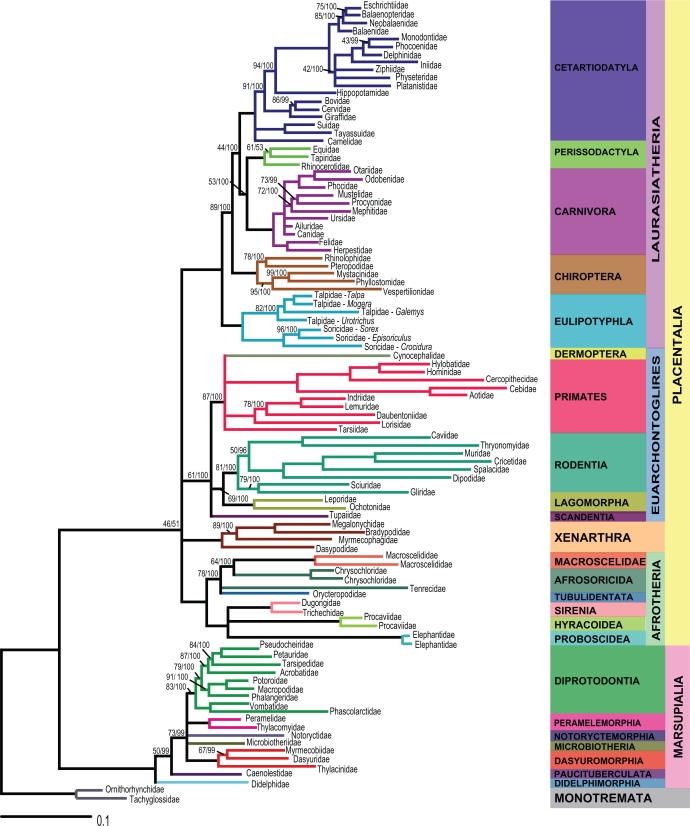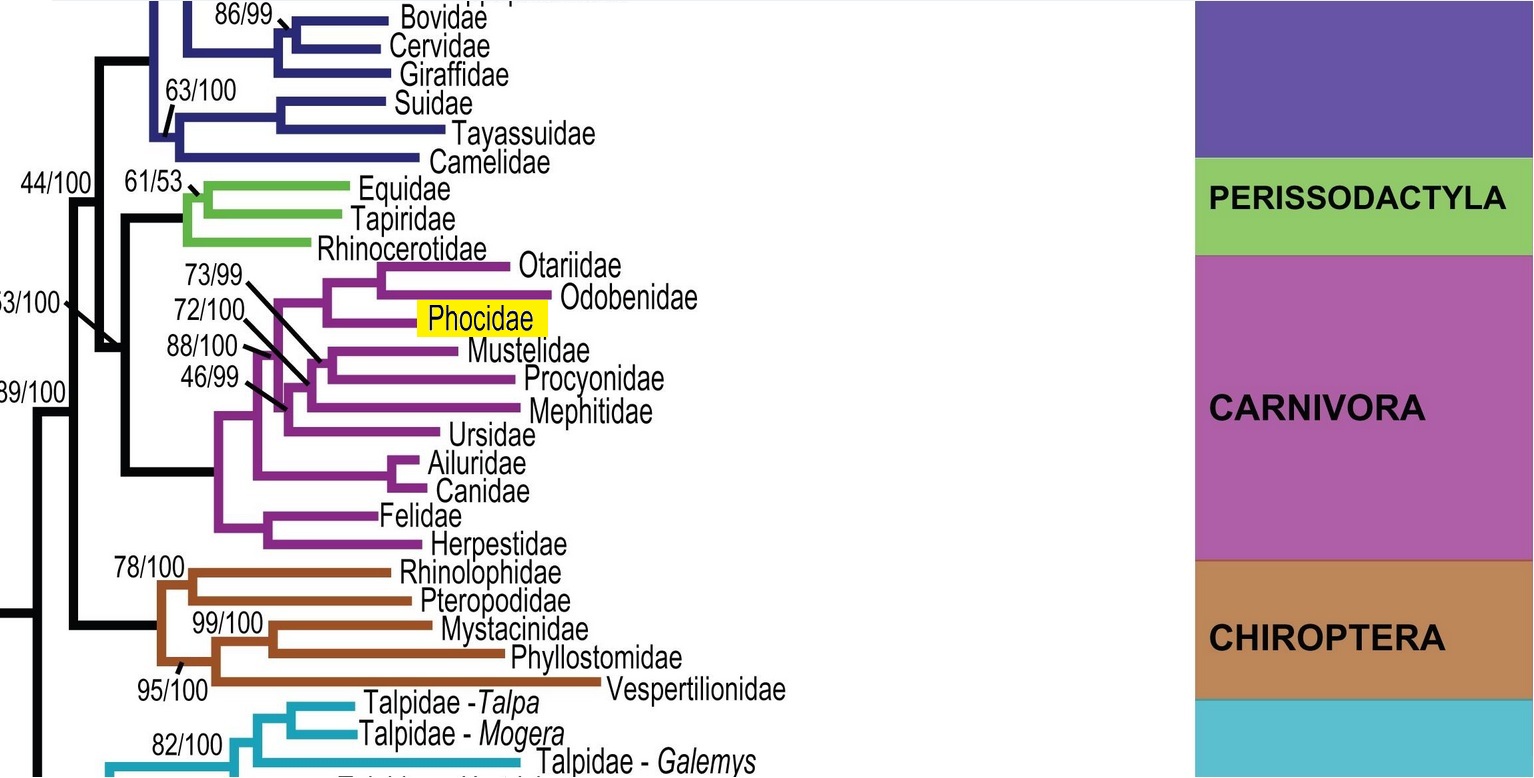Classification
Domain – Eukarya
Kingdom – Animalia
Phylum – Chordata
Class –
Mammalia
Order – Carnivora
Family – Phocidae
Genus – Phoca
Species – Phoca vitulina
Organizational hierarchy of Phoca vitulina (NOAA
Fisheries, 2013).
Molecular tree of living pinnipeds (except for extinct Monachus) based on fifty most likely phylogenies. This phylogeny represents a hypothesis on a species specific level of the relatedness between pinniped species. If you are curious on what a pinniped is, the Marine Mammal Center explains the term quite effectively. Phoca vitulina appears to be most closely related to Phoca largha (the spotted seal). Photo credit to Jeff W. Higdon et al. licensee BioMed Central Ltd (© 2007) with slight modification by Daniel Nash.
Phylogenetic supertree composed of ninety three mammalian families representing relationships based on mitochondrial DNA sequencing (for more information on mtDNA, scroll down this page). The numbers correspond to Bayesian posterior probabilities. Photo credit to Véronique Campbell and François-Joseph Lapointe.
Zoomed in view of the
prior supertree with
significance directed towards family Phocidae, "true seals," where the
harbor seal resides. Phocidae lies within order Carnivora being most
closely related to families Otariidae and Odobenidae (eared seals and
walruses, respectively). Photo credit to Véronique Campbell and
François-Joseph Lapointe with slight modification by Danny Nash.
What is mtDNA?
The phylogenetic trees above are all based on mitochondrial DNA
(mtDNA)
sequences. Mitochondrial DNA is genetic information located within
mitochondria which aid in the functioning of the organelle
(Genetics Home Reference, 2013). This type of DNA is inherited through
the mother alone (unlike nuclear DNA which is composed of both the
mother's and father's DNA), making mtDNA a critical component to many
phylogenetic tree constructions (Nova Online, 2002).
Binomial Nomenclature
The scientific naming system (Binomial
Nomenclature) uses Latin roots which organizes the vast array of
life into tangible groups. This nomenclature is essential to any
taxonomist, but they do not help the average individual understand
why the organism is classified in a particular manner. Below are the
groups P. vitulina fits into, and why.

Eukarya
To be classified in Eukarya, the organism must possess membrane
bound organelles including a nucleus. These organisms are considered
eukaryotes, which roughly translates to “true kernel” (Encyclopedia
of Life: Eukaryotes, 2012).
Animalia
Animalia is a group of individuals who obtain their food through
means other than their own production. They can be thought of as the
consumers in the food chain, feeding on other organisms in order to
survive (Encyclopedia of Life: Animalia, 2012).
Chordata
Phylum Chordata have characteristics which include a dorsal hollow
nerve chord, pharyngeal gill slits, and even a muscular tail (at
some point in development). They also tend to display bilateral
symmetry due to their triploblastic (three tissue) nature
(Encycopedia of Life: Chordata, 2012).
Mammalia
Mammalia, also known as mammals, host organisms which produce milk
in specialized glands. This milk is then fed to their young as a
source of nourishment. During some point in their lifespan, mammals
have hair (which can be permanent or, in my father’s case,
temporary) (Encyclopedia of Life: Mammalia, 2012).
Carnivora
Carnivores are typically defined as the "meat-eaters" of the
animal kingdom. However, there are individuals in this order which are
omnivorous (those which eat both plants, and animals). There are also
handfuls of species not included in Carnivora which have diets
comprised primarily of meat. With that we can conclude that all
carnivores eat meat, but not all "meat-eaters" are carnivores
(Encyclopedia of Life: Carnivora, 2012).
Phocidae
This family contains all of the "true seals" (such
as the
harp seal). To be qualified
in this family members must contain some general characteristics, such
as a rounded body, the inability to rotate hind flippers forward, and
have an absence of external ear flaps (SeaWorld, 2005). Individuals of
this group tend to be crafted for water, not land. This can be seen
from their limited mobility and poor vision on terrestrial surfaces
(Encyclopedia of Life: Phocidae, 2012).
Phoca
To be considered into this genus, individuals must be a "true seal"
(which they will be due to categorization into the family Phocidae)
and have hair (The Integrated Taxonomic Information System, 2013).
Phoca vitulina
Phoca vitulina literally means (translated from latin)
"calf-like" seal (Denver Zoological Foundation, 2000). This species
happens to have five subspecies, also known as forms,
which increases the overall diversity of P. vitulina. The
major differences in these subspecies are attributed to their geographic
distribution throughout the world
(Seal Conservation Society, 2011). For more information on the
subspecies, visit the habitat page.
Phoca vitulina is most commonly referred to as the harbor seal.
But where did this species get its name? Typically seals go to an on
shore location every reproductive season to mate, feed, and raise
their young. These coastal landmarks (called haul-out sites) provide
protection from predators, and harsh weather. The protection these
seals receive is how they developed the name harbor seal (Seal
Conservation Society, 2011).
Image by Daniel Nash with
information derived from NOAA
Fisheries



